Sicilian Journal
1/20
Left Istanbul at 2:30 on flight for Catania. Began Calvino's If on a winter's night a traveler on the plane. I've never read anything of his since Invisible Cities, which made such an impression on me -- not sure why I never pursued more. Fantastic beginning in which the author leads you (the reader) to a bookstore to buy his new book. This would fall flat in other hands, but there is something light about Calvino that allows him to succeed. Next, a chapter in which a man in a train station waits for--? And the narrative ceases.
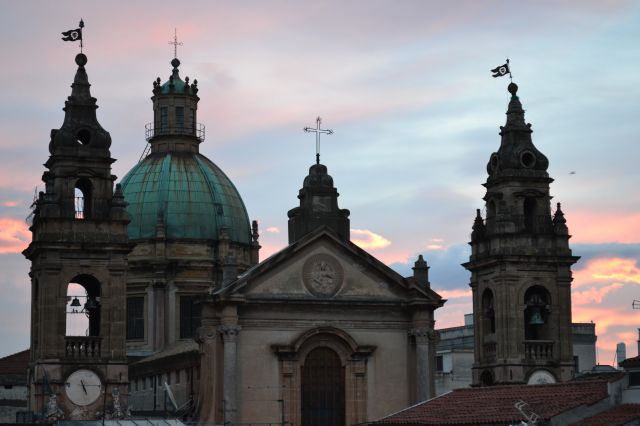 When we arrived in Palermo it was dark already. We drove northwest through green, hilly farmland mostly. I expected something drier, more like Spain. When we arrived in the neighborhood we were immediately lost in a tangle of narrow streets, driving in circles. Like the cities in Andalusia, this place was clearly not built for cars, which sadly (sad at my own reaction) frustrated me. We met our host, and he helped us put the car away. We are staying on Via Orologio, right by the Teatro Massimo opera house, which has a clock tower at its end, appropriately. We are in an apartment on the top of an old building, reached by a set of stairs that crosses back and forth over a courtyard. It is now covered with a corrugated steel roof but looks like it must have originally been open-air. The streets around the place were packed with people, all out on a Sunday night. We ate in the square in front of the church with the clock tower and went to bed.
When we arrived in Palermo it was dark already. We drove northwest through green, hilly farmland mostly. I expected something drier, more like Spain. When we arrived in the neighborhood we were immediately lost in a tangle of narrow streets, driving in circles. Like the cities in Andalusia, this place was clearly not built for cars, which sadly (sad at my own reaction) frustrated me. We met our host, and he helped us put the car away. We are staying on Via Orologio, right by the Teatro Massimo opera house, which has a clock tower at its end, appropriately. We are in an apartment on the top of an old building, reached by a set of stairs that crosses back and forth over a courtyard. It is now covered with a corrugated steel roof but looks like it must have originally been open-air. The streets around the place were packed with people, all out on a Sunday night. We ate in the square in front of the church with the clock tower and went to bed.
1/21
Woke up at 7:15, just in time to hear the church bells. Our patio looks out on a green-domed church with twin clock towers (one of which is visible at the end our street). Looking southward, there are green mountains. Made coffee in a moka pot and looked out at the view for a bit. After another adventure moving the car (driving here has something in common with the feeling of swarming insects) headed out for breakfast. After pastries and more coffee, walked in the direction of Quattro Conti -- the square where the two main streets of Palermo cross. We stumbled across the beautiful Pretoria fountain with all its marble figures a stunning white in an otherwise decrepit square. Just down the street we found the red-comed San Cataldo church, which Oya and I both mistook for a converted mosque but is in fact a piece of Arab-Norman architecture unique to the island. In the square is the beautiful Byzantine church, La Martorana, full of gilded mosaics and geometric tiled floors. It has elements of St. Mark's in Venice but all in perfect condition. This was a sharp contrast to the streets outside, where everything is slowly decaying.
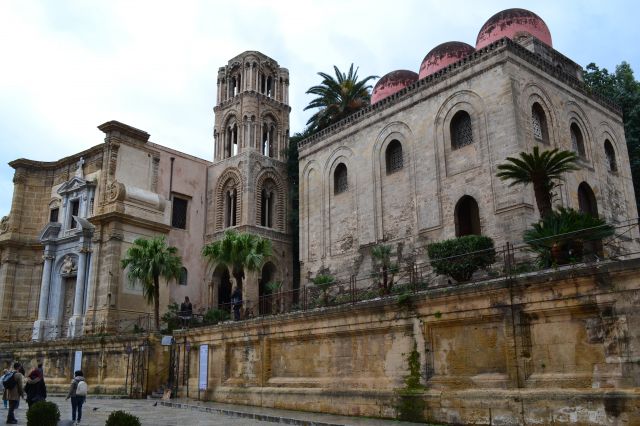
Palermo is a grimy city, not scrubbed for tourists like Rome. The further south we walked, the poorer it became. There are a lot of immigrants here, from Africa and India, and there are stands selling cheap clothes and shoes that reminded me of things we have seen around the Middle East more than in Europe. There is a different smell here than in other parts of Italy -- unfamiliar spices wafting through every street. The food available at the restaurants is different, too --not the Italian staples. We had lunch at Bisso Bistrot near Quattro Conti, which was very urbane. Had lamb in lemon sauce and a long, tubular pasta with pumpkin, chicory and fish. After lunch, we continued south toward the Botanical Gardens, which have a mock-Egyptian building on their grounds. Rather than going in, though, we decided to sit for a bit in the Villa Giulia gardens next door while our Julia could run around.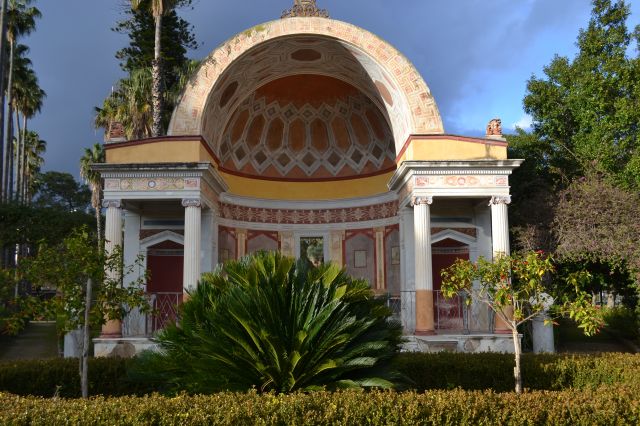 There were some orange trees in the gardens, and Julia wanted to pick an orange for her mom, so we did, but it was the most bitter and sour thing any of us had ever tasted. The walk was a bit of a bust, but we walked up the seaside road on the way back and saw a double-rainbow! The whole time we have been here, it has been misting and lightly raining, then sunny. We found a cafe in a street where everything else seemed to be closed and had a cannoli and coffee. We ended the day with pizza for dinner right on our street.
There were some orange trees in the gardens, and Julia wanted to pick an orange for her mom, so we did, but it was the most bitter and sour thing any of us had ever tasted. The walk was a bit of a bust, but we walked up the seaside road on the way back and saw a double-rainbow! The whole time we have been here, it has been misting and lightly raining, then sunny. We found a cafe in a street where everything else seemed to be closed and had a cannoli and coffee. We ended the day with pizza for dinner right on our street.
1/22
After breakfast we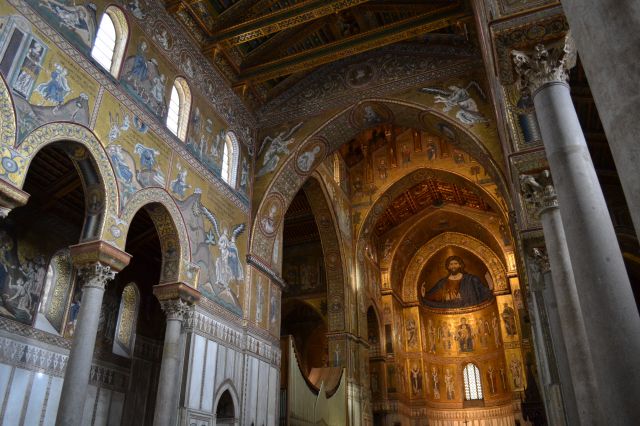 took a road trip intended to last half the day, which instead went until evening. We drove out the the village of Monreale, on a hilltop outside of Palermo with the sole purpose of seeing its cathedral. I have been been to a lot of cathedrals, but this one is possibly the best. The whole church is covered in the same gilded mosaics from yesterday but in a space maybe ten times as large. It seemed like every single story from The Bible was depicted on the walls, which couldn't be possible, but it must have been close. We departed Monreale toward Segesta. The road was mostly dull, passing through small towns and collonaded tunnels. Right before Segesta it became greener and more scenic -- the view I saw from the top of the hill later was some of the most beautiful farmland I can remember: so many shades of green in a patchwork laid over the hillside.
took a road trip intended to last half the day, which instead went until evening. We drove out the the village of Monreale, on a hilltop outside of Palermo with the sole purpose of seeing its cathedral. I have been been to a lot of cathedrals, but this one is possibly the best. The whole church is covered in the same gilded mosaics from yesterday but in a space maybe ten times as large. It seemed like every single story from The Bible was depicted on the walls, which couldn't be possible, but it must have been close. We departed Monreale toward Segesta. The road was mostly dull, passing through small towns and collonaded tunnels. Right before Segesta it became greener and more scenic -- the view I saw from the top of the hill later was some of the most beautiful farmland I can remember: so many shades of green in a patchwork laid over the hillside.
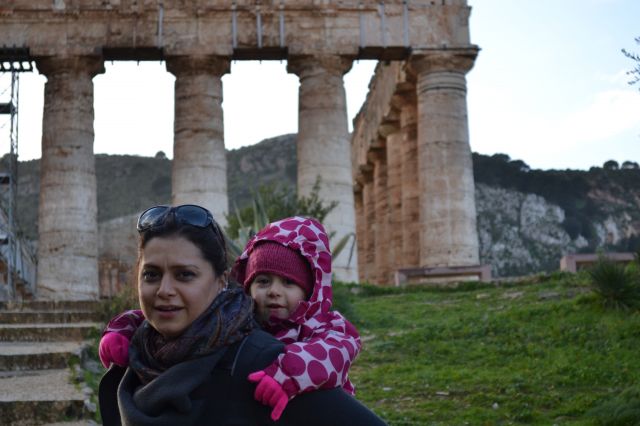
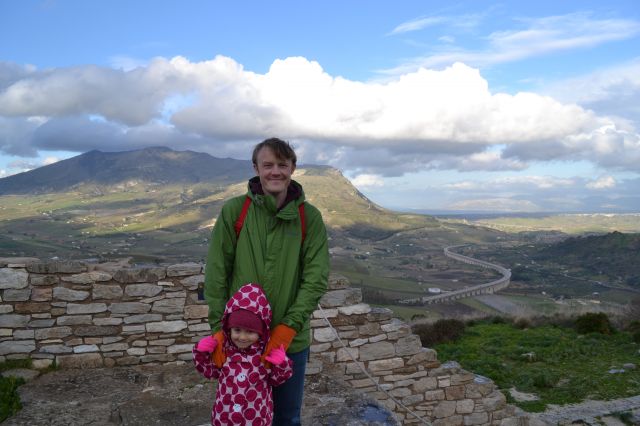
We had lunch at an empty restaurant, with only one other person dining, who ate an entire octopus. Afterwards we took a bus up to the entrance of the archaeological park, then a second bus to the amphitheater at the very top of the hill, where took in the aforementioned view. Finally, we came to the main event: the solitary Greek temple. The temple is built on three dozen Doric columns, all standing, only weathered over the past 2,600 years. Had I not been to Paestum a few years ago, the sight would have been even more startling -- the fact of it being there, in nearly perfect condition, in the middle of nowhere. After contemplating the "ruins," we drove home as the darkness fell over the countryside.
Back in Palermo, we had dinner at L'Osteria de Bianco in the new town north of the opera house where we had a couple of Sicilian dishes: caponata, made from eggplant and celery, slightly sweet and sour, fish balls with breadcrumbs, pine nuts and raisins in tomato sauce, and pistacchio cassata for dessert.
1/23
After a long hassle trying to exchange money, we took one last walk through the old town of Palermo, this time to the Norman palace and cathedral. The real find, however, was a street of antiques dealers operating out of two rows of shacks with corrugated steel siding and trees growing out of their roofs which, at some spots, looked as though the metal had fused with the living wood. We bought a heavy platter with an image of two fish on it in blues and greens similar to the ones you see in newer Sicilian pottery (which tends to be in yellow and turquoise on white). Coming from Turkey, where there is so much pottery, there isn't much that catches my eye, but this one did for its almost crudeness of design. The whole scene was so distinct -- the shacks in such contrast to the substantialness of everything else in Palermo. Our treasure under arm, we found our car and set out.
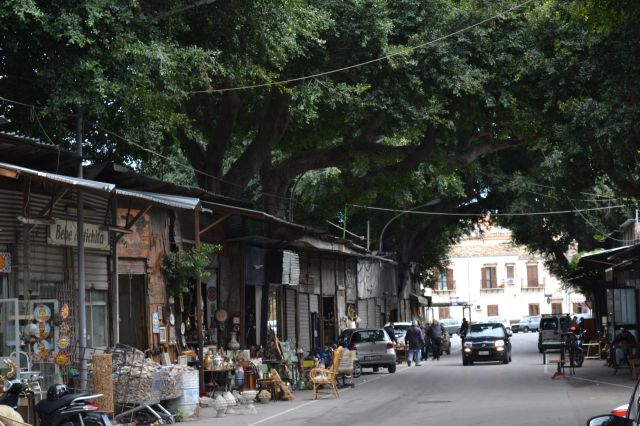
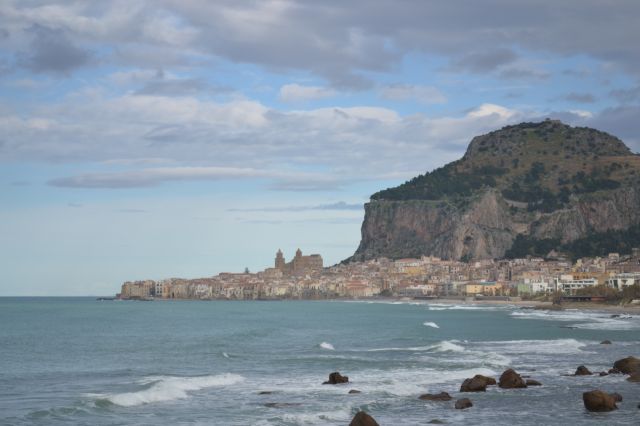
Our first stop was the seaside town of Cefalu, which was more or less empty. We ate panini, and I had a local soft drink called chinotto, made from the island's bitter oranges. Afterwards we walked to the cathedral, which is part of the same Arab-Norman tradition. This one seemed to have been stripped bare inside. We had initially thought to drive the coast all the way to Syracuse but started too late in the day so took the highway through the center of the island instead. We arrived at our B&B after dark.
1/24
The house where we are staying is old (18th or 19th century) with heavy wooden beams on the ceilings -- a single-story house with a lemon garden in its courtyard. I started the day making coffee in a moka pot, which I have become more adept at. The kitchen looks like something from a farmhouse, with piles of old biscuit tins stacked on top of the cabinets. The kitchen smells heavily of tobacco smoke, from our host who walks in and out with either a lit pipe or cigar in his mouth. We had several slices of a vanilla cake called pandoro, covered in powdered sugar.
After breakfast we headed to the island of Ortygia -- Syracuse's baroque city city center. Arriving just before lunchtime, nothing seemed to be open. At the heart of Ortygia is the Piazza del Duomo and the massive white marble cathedral with its two levels and a grand staircase. The cathedral is not so interesting inside, nor is the church of Santa Lucia adjacent to it, but the piazza itself is unbeatable. It began to rain hard, and so we ducked into one of the streets behind the square and found the little Osteria da Mariano, where I had a lunch of rabbit. After the rain let up, we took a walk around the perimeter of Ortygia, atop the walls of the promontory. A ramp led us down to a small beach, a green natural pool and a grove of trees with vine-like roots, like something out of Vietnam. Sicily is like that: a Mediterranean island with almost tropical elements.
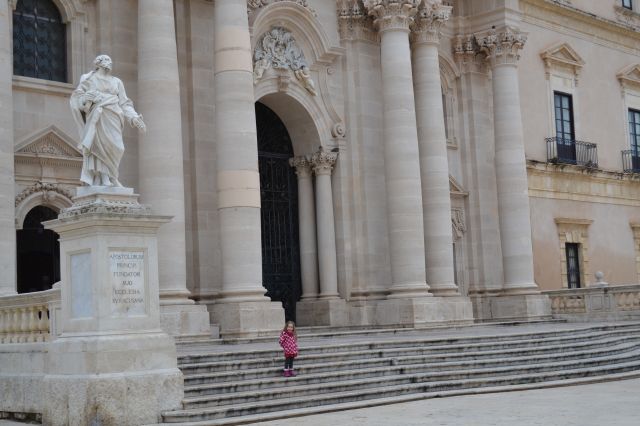
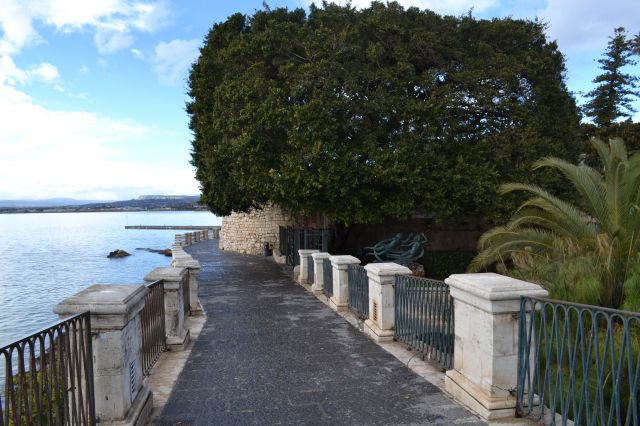
I have continued the Calvino novel -- a story about a reader trying to finish a book he has started but only ever getting a chapter into any story before there is some defect to the book which makes him seek a replacement, always inevitably the wrong book. The conceit is funny, but we'll see if he manages to keep each new chapter interesting.
1/25
One of Oya's and my main reasons for coming to Sicily was The Godfather. Today we drove north, past Mt. Etna, to the village of Savoca, where the Sicilian scenes were shot. To reach the village, you climb the twistiest road of switchbacks I have ever seen, with prickly pear cactus growing on the exposed rock, so close you could touch them from the car window. At the top, there is a single road that follows the crest of the hill, turning in a loop around the village square. Once we managed to park, here is what we found: at the center, the Bar Vitelli, where Michael meets Apollonia, intact except for the bead curtain which it has since lost. Across from the road from the cafe is a small park that looks out across the other hills that rise like massive green knees from the landscape. Beyond the hills is the sea, as is the case nearly everywhere. From there a narrow road follows the ridge out to a church where the wedding takes place in the film. We found a deli where they made us sandwiches with prosciutto, homemade ricotta cheese, olive oil and dried oregano straight from the stalk, applied by stroking the herb and letting it fall onto the bread. They served us homemade red wine, too, and had the little stone building not been freezing, it would have been the perfect lunch. Afterward, we had a coffee and cannoli at Bar Vitelli, whose walls are covered in stills from the film and whose speakers pipe out Nino Rota 24/7 -- so touristy in this place that seems otherwise off the beaten track. It's funny how this village, since it shaped my expectations for Sicily, is also the only place that has delivered on those promises so far.
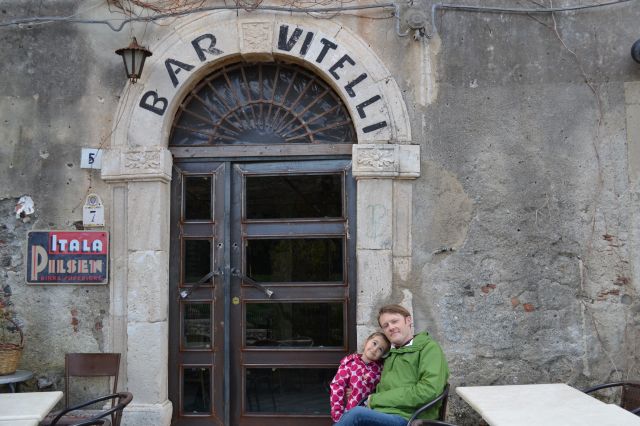
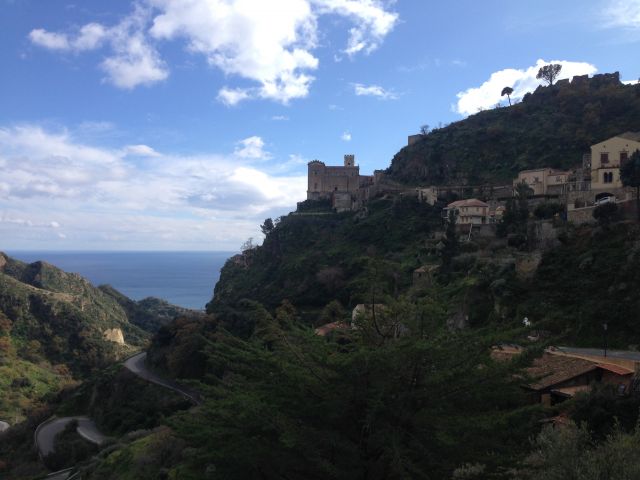
On the way home, we stopped in the village of Forza d'Agro -- also atop a hill with maybe a dozen switchbacks -- to see a church used in The Godfather Part II. The church -- which reminded me of those mission-style churches in Westerns set in Mexico -- was unlocked but empty, and as we came out it was just beginning to rain. We took the slow road back to Syracuse, passing but not stopping in Taormina and a series of other towns as the sky grew dark. Back in Syracuse, we headed back to Ortygia for one last meal we had lunch at yesterday. I had spaghetti in fresh squid ink.
1/26
Our final day turned out much different than we expected. After breakfast, we loaded the car and drove north to Catania. On the way we received notice that our flight was canceled. We continued on regardless, as we needed to return the car. When we arrived at the airport, they told us Mt. Etna had spewed ash onto the runway that morning and that all flights were being canceled. Through the floor-to-ceiling windows, we could see a plume of smoke rising from the volcano. We were carted off to a hotel for the night. The evening was uneventful except that Julia and I took a walk before dinner and wandered into a festival dedicated to St. Agatha in the adjacent village complete with a medieval jousting tournament! A surreal end to the trip.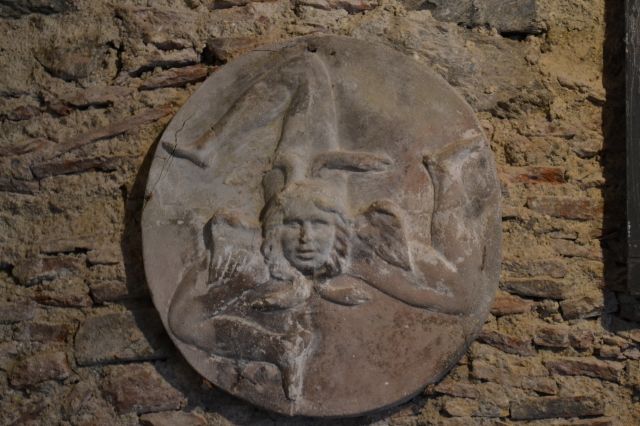
Left Istanbul at 2:30 on flight for Catania. Began Calvino's If on a winter's night a traveler on the plane. I've never read anything of his since Invisible Cities, which made such an impression on me -- not sure why I never pursued more. Fantastic beginning in which the author leads you (the reader) to a bookstore to buy his new book. This would fall flat in other hands, but there is something light about Calvino that allows him to succeed. Next, a chapter in which a man in a train station waits for--? And the narrative ceases.
 When we arrived in Palermo it was dark already. We drove northwest through green, hilly farmland mostly. I expected something drier, more like Spain. When we arrived in the neighborhood we were immediately lost in a tangle of narrow streets, driving in circles. Like the cities in Andalusia, this place was clearly not built for cars, which sadly (sad at my own reaction) frustrated me. We met our host, and he helped us put the car away. We are staying on Via Orologio, right by the Teatro Massimo opera house, which has a clock tower at its end, appropriately. We are in an apartment on the top of an old building, reached by a set of stairs that crosses back and forth over a courtyard. It is now covered with a corrugated steel roof but looks like it must have originally been open-air. The streets around the place were packed with people, all out on a Sunday night. We ate in the square in front of the church with the clock tower and went to bed.
When we arrived in Palermo it was dark already. We drove northwest through green, hilly farmland mostly. I expected something drier, more like Spain. When we arrived in the neighborhood we were immediately lost in a tangle of narrow streets, driving in circles. Like the cities in Andalusia, this place was clearly not built for cars, which sadly (sad at my own reaction) frustrated me. We met our host, and he helped us put the car away. We are staying on Via Orologio, right by the Teatro Massimo opera house, which has a clock tower at its end, appropriately. We are in an apartment on the top of an old building, reached by a set of stairs that crosses back and forth over a courtyard. It is now covered with a corrugated steel roof but looks like it must have originally been open-air. The streets around the place were packed with people, all out on a Sunday night. We ate in the square in front of the church with the clock tower and went to bed.1/21
Woke up at 7:15, just in time to hear the church bells. Our patio looks out on a green-domed church with twin clock towers (one of which is visible at the end our street). Looking southward, there are green mountains. Made coffee in a moka pot and looked out at the view for a bit. After another adventure moving the car (driving here has something in common with the feeling of swarming insects) headed out for breakfast. After pastries and more coffee, walked in the direction of Quattro Conti -- the square where the two main streets of Palermo cross. We stumbled across the beautiful Pretoria fountain with all its marble figures a stunning white in an otherwise decrepit square. Just down the street we found the red-comed San Cataldo church, which Oya and I both mistook for a converted mosque but is in fact a piece of Arab-Norman architecture unique to the island. In the square is the beautiful Byzantine church, La Martorana, full of gilded mosaics and geometric tiled floors. It has elements of St. Mark's in Venice but all in perfect condition. This was a sharp contrast to the streets outside, where everything is slowly decaying.

Palermo is a grimy city, not scrubbed for tourists like Rome. The further south we walked, the poorer it became. There are a lot of immigrants here, from Africa and India, and there are stands selling cheap clothes and shoes that reminded me of things we have seen around the Middle East more than in Europe. There is a different smell here than in other parts of Italy -- unfamiliar spices wafting through every street. The food available at the restaurants is different, too --not the Italian staples. We had lunch at Bisso Bistrot near Quattro Conti, which was very urbane. Had lamb in lemon sauce and a long, tubular pasta with pumpkin, chicory and fish. After lunch, we continued south toward the Botanical Gardens, which have a mock-Egyptian building on their grounds. Rather than going in, though, we decided to sit for a bit in the Villa Giulia gardens next door while our Julia could run around.
 There were some orange trees in the gardens, and Julia wanted to pick an orange for her mom, so we did, but it was the most bitter and sour thing any of us had ever tasted. The walk was a bit of a bust, but we walked up the seaside road on the way back and saw a double-rainbow! The whole time we have been here, it has been misting and lightly raining, then sunny. We found a cafe in a street where everything else seemed to be closed and had a cannoli and coffee. We ended the day with pizza for dinner right on our street.
There were some orange trees in the gardens, and Julia wanted to pick an orange for her mom, so we did, but it was the most bitter and sour thing any of us had ever tasted. The walk was a bit of a bust, but we walked up the seaside road on the way back and saw a double-rainbow! The whole time we have been here, it has been misting and lightly raining, then sunny. We found a cafe in a street where everything else seemed to be closed and had a cannoli and coffee. We ended the day with pizza for dinner right on our street.1/22
After breakfast we
 took a road trip intended to last half the day, which instead went until evening. We drove out the the village of Monreale, on a hilltop outside of Palermo with the sole purpose of seeing its cathedral. I have been been to a lot of cathedrals, but this one is possibly the best. The whole church is covered in the same gilded mosaics from yesterday but in a space maybe ten times as large. It seemed like every single story from The Bible was depicted on the walls, which couldn't be possible, but it must have been close. We departed Monreale toward Segesta. The road was mostly dull, passing through small towns and collonaded tunnels. Right before Segesta it became greener and more scenic -- the view I saw from the top of the hill later was some of the most beautiful farmland I can remember: so many shades of green in a patchwork laid over the hillside.
took a road trip intended to last half the day, which instead went until evening. We drove out the the village of Monreale, on a hilltop outside of Palermo with the sole purpose of seeing its cathedral. I have been been to a lot of cathedrals, but this one is possibly the best. The whole church is covered in the same gilded mosaics from yesterday but in a space maybe ten times as large. It seemed like every single story from The Bible was depicted on the walls, which couldn't be possible, but it must have been close. We departed Monreale toward Segesta. The road was mostly dull, passing through small towns and collonaded tunnels. Right before Segesta it became greener and more scenic -- the view I saw from the top of the hill later was some of the most beautiful farmland I can remember: so many shades of green in a patchwork laid over the hillside.

We had lunch at an empty restaurant, with only one other person dining, who ate an entire octopus. Afterwards we took a bus up to the entrance of the archaeological park, then a second bus to the amphitheater at the very top of the hill, where took in the aforementioned view. Finally, we came to the main event: the solitary Greek temple. The temple is built on three dozen Doric columns, all standing, only weathered over the past 2,600 years. Had I not been to Paestum a few years ago, the sight would have been even more startling -- the fact of it being there, in nearly perfect condition, in the middle of nowhere. After contemplating the "ruins," we drove home as the darkness fell over the countryside.
Back in Palermo, we had dinner at L'Osteria de Bianco in the new town north of the opera house where we had a couple of Sicilian dishes: caponata, made from eggplant and celery, slightly sweet and sour, fish balls with breadcrumbs, pine nuts and raisins in tomato sauce, and pistacchio cassata for dessert.
1/23
After a long hassle trying to exchange money, we took one last walk through the old town of Palermo, this time to the Norman palace and cathedral. The real find, however, was a street of antiques dealers operating out of two rows of shacks with corrugated steel siding and trees growing out of their roofs which, at some spots, looked as though the metal had fused with the living wood. We bought a heavy platter with an image of two fish on it in blues and greens similar to the ones you see in newer Sicilian pottery (which tends to be in yellow and turquoise on white). Coming from Turkey, where there is so much pottery, there isn't much that catches my eye, but this one did for its almost crudeness of design. The whole scene was so distinct -- the shacks in such contrast to the substantialness of everything else in Palermo. Our treasure under arm, we found our car and set out.


Our first stop was the seaside town of Cefalu, which was more or less empty. We ate panini, and I had a local soft drink called chinotto, made from the island's bitter oranges. Afterwards we walked to the cathedral, which is part of the same Arab-Norman tradition. This one seemed to have been stripped bare inside. We had initially thought to drive the coast all the way to Syracuse but started too late in the day so took the highway through the center of the island instead. We arrived at our B&B after dark.
1/24
The house where we are staying is old (18th or 19th century) with heavy wooden beams on the ceilings -- a single-story house with a lemon garden in its courtyard. I started the day making coffee in a moka pot, which I have become more adept at. The kitchen looks like something from a farmhouse, with piles of old biscuit tins stacked on top of the cabinets. The kitchen smells heavily of tobacco smoke, from our host who walks in and out with either a lit pipe or cigar in his mouth. We had several slices of a vanilla cake called pandoro, covered in powdered sugar.
After breakfast we headed to the island of Ortygia -- Syracuse's baroque city city center. Arriving just before lunchtime, nothing seemed to be open. At the heart of Ortygia is the Piazza del Duomo and the massive white marble cathedral with its two levels and a grand staircase. The cathedral is not so interesting inside, nor is the church of Santa Lucia adjacent to it, but the piazza itself is unbeatable. It began to rain hard, and so we ducked into one of the streets behind the square and found the little Osteria da Mariano, where I had a lunch of rabbit. After the rain let up, we took a walk around the perimeter of Ortygia, atop the walls of the promontory. A ramp led us down to a small beach, a green natural pool and a grove of trees with vine-like roots, like something out of Vietnam. Sicily is like that: a Mediterranean island with almost tropical elements.


I have continued the Calvino novel -- a story about a reader trying to finish a book he has started but only ever getting a chapter into any story before there is some defect to the book which makes him seek a replacement, always inevitably the wrong book. The conceit is funny, but we'll see if he manages to keep each new chapter interesting.
1/25
One of Oya's and my main reasons for coming to Sicily was The Godfather. Today we drove north, past Mt. Etna, to the village of Savoca, where the Sicilian scenes were shot. To reach the village, you climb the twistiest road of switchbacks I have ever seen, with prickly pear cactus growing on the exposed rock, so close you could touch them from the car window. At the top, there is a single road that follows the crest of the hill, turning in a loop around the village square. Once we managed to park, here is what we found: at the center, the Bar Vitelli, where Michael meets Apollonia, intact except for the bead curtain which it has since lost. Across from the road from the cafe is a small park that looks out across the other hills that rise like massive green knees from the landscape. Beyond the hills is the sea, as is the case nearly everywhere. From there a narrow road follows the ridge out to a church where the wedding takes place in the film. We found a deli where they made us sandwiches with prosciutto, homemade ricotta cheese, olive oil and dried oregano straight from the stalk, applied by stroking the herb and letting it fall onto the bread. They served us homemade red wine, too, and had the little stone building not been freezing, it would have been the perfect lunch. Afterward, we had a coffee and cannoli at Bar Vitelli, whose walls are covered in stills from the film and whose speakers pipe out Nino Rota 24/7 -- so touristy in this place that seems otherwise off the beaten track. It's funny how this village, since it shaped my expectations for Sicily, is also the only place that has delivered on those promises so far.


On the way home, we stopped in the village of Forza d'Agro -- also atop a hill with maybe a dozen switchbacks -- to see a church used in The Godfather Part II. The church -- which reminded me of those mission-style churches in Westerns set in Mexico -- was unlocked but empty, and as we came out it was just beginning to rain. We took the slow road back to Syracuse, passing but not stopping in Taormina and a series of other towns as the sky grew dark. Back in Syracuse, we headed back to Ortygia for one last meal we had lunch at yesterday. I had spaghetti in fresh squid ink.
1/26
Our final day turned out much different than we expected. After breakfast, we loaded the car and drove north to Catania. On the way we received notice that our flight was canceled. We continued on regardless, as we needed to return the car. When we arrived at the airport, they told us Mt. Etna had spewed ash onto the runway that morning and that all flights were being canceled. Through the floor-to-ceiling windows, we could see a plume of smoke rising from the volcano. We were carted off to a hotel for the night. The evening was uneventful except that Julia and I took a walk before dinner and wandered into a festival dedicated to St. Agatha in the adjacent village complete with a medieval jousting tournament! A surreal end to the trip.

Don't miss what's next. Subscribe to Ned Entrikin's Travels: